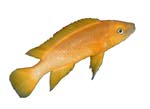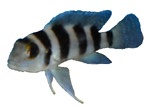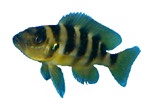
Neolamprologus - This genus which is endemic to Lake Tanganyika is best divided into a few groups. All Neolamprologus are micro-predators.
|
"Shell Dwelling" Neolamprologus - Most of these species which fall into this category are dwarfs (N. brevis, N. caudopunctatus, N. occelatus, N. multifaciatus, N specious ) and can easily be housed in tanks as small as 10 gallons. The larger shell dwellers (N. callipterus, N. kungweensis) can be housed in smaller tanks (i.e.. 20 gallons) although they may not exhibit their full range of natural behavior in tanks less than 55 gallons. In any tank housing these fish, there should be at least 2 appropriately sized shells per fish to allow adequate territories for all shell dwelling residents. The shells of the edible snail which can be purchased at delicatessens, are the ideal size and shape for most shell-dwellers. These fish spawn either as monogamous pairs, or, if present in sufficient numbers, they may occasionally spawn as a group or colony, where everyone guards everyone's fry. |

Neolamprologus hequi |

Neolamprologus multifasciatus |

Neolamprologus meleagrise |

Neolamprologus calliurus "Giant" |
|
"Brichardi-Type" Neolamprologus - This group includes N. brichardi, N. pulcher "Daffodil", N. falcicula "Walteri", N. crystiyi, N. gracilis, N. maraguensis, & N. pulcher. All these fish are collectively known as "Fairy Cichlids". They are plankton feeders. All have a similar body shape, with extensions off the top and bottom of the caudal fin (tail). All these species are relatively peaceful. They are all substrate spawners, and, depending on the numbers present, they may form polygamous pairs, spawn as a harem, or as a colony. They can be kept as a pair in tanks as small as 10 gallons, in groups a minimum tank size of 20+ will be better. |

Neolamprologus falcicula"Walteri" |

Neolamprologus gracilis |

Neolamprologus pulcher |

Neolamprologus cygnus
(Juvenile) |

Neolamprologus maraguensis
(Adult) |
|
All other Neolamprologus sp. - The rest of the Neolamprologus tend to be more aggressive, and also may attain larger sizes. Other than that, they are no different from most others of this genus. They usually do not practice any other kind of spawning method other than monogamous substrate spawning. The smallest species can be kept in tanks 20 gallons +, although most of these Cichlids do best in tanks 30+, mostly depending on their adult size. The larger species (N. tretocephalus, N. sexfaciatus, N. faciatus ) do best in tanks with a minimum size of 55 gallons. |

Neolamprologus leleupi |

Neolamprologus tretocephalus |

Neolamprologus tretracanthus |

Neolamprologus sexfasciatus"Gold" |
|